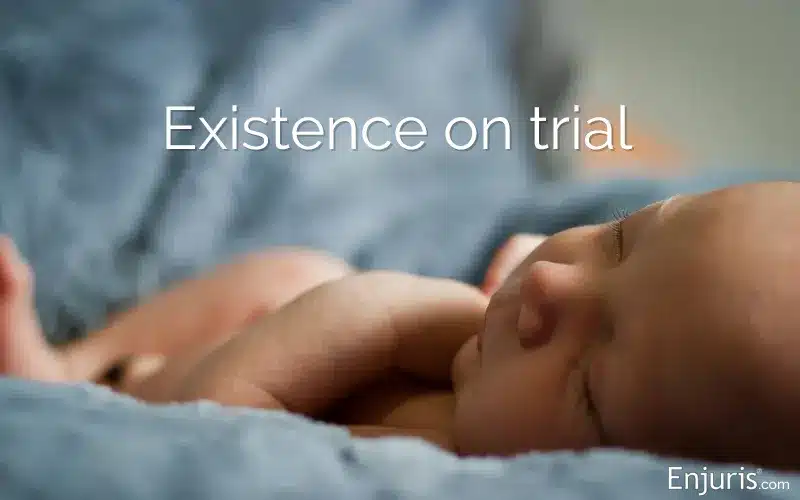
Imagine a world where your mere existence is a legal question. This is the reality for those at the heart of wrongful life lawsuits—not to be confused with wrongful death lawsuits.
Let’s take a closer look at this controversial area of law.
What is a wrongful life lawsuit?
A wrongful life lawsuit is a personal injury lawsuit in which the plaintiff alleges that they would have been better off never having been born and, but for the defendant’s negligence, would not have, in fact, been born.
Wrongful life lawsuits are typically filed by or on behalf of severely disabled individuals.
Consider the following case from Washington:
Yesenia Pacheco became pregnant in 2011 after a health clinic negligently gave her a flu vaccine instead of the Depo-Provera contraceptive she requested. The clinic did not inform Yesenia of the mistake until she called to make her next appointment, at which point she was already pregnant.
Yesenia’s child was born “horribly disabled,” with a condition that causes cognitive delays, slowed speech and language skills, epilepsy, and blindness.
Yesenia filed a wrongful life lawsuit, alleging that her child would not have been born were it not for the negligence of the health clinic.
Following a trial in 2020, a judge awarded the child and Yesenia $10 million, which included $7.5 million for the child’s medical, education, and other expenses, as well as $2.5 million in damages for Yesenia.
Although less common, wrongful life lawsuits can also involve situations in which medical professionals save someone's life even though the patient made clear they did not want to be saved.
Consider the following case from Montana:
A Montana jury awarded $209,000 for medical costs and $200,000 for mental and physical pain and suffering in a landmark wrongful life case involving Rodney Knoepfle.
Rodney, 67 years old, was admitted to St. Peter’s Health in Helena for a relatively common procedure. Rodney had a long history of serious medical conditions, including congestive heart failure, chronic atrial fibrillation, coronary artery bypass, and osteomyelitis.
Rodney had a do-not-resuscitate order form on file at St. Peter’s Health. What’s more, on the date of admission, a physician placed an order in the chart confirming his resuscitation status of “DNR,” and he was fitted with a blue armband indicating to all providers his DNR status.
Despite this directive, Rodney was resuscitated twice by the medical team, leading to an additional two years of life in which he was “almost incoherent with pain.”
How wrongful life lawsuits differ from similar claims
States recognize several birth-related torts, including wrongful conception, wrongful pregnancy, and wrongful birth.
These terms might seem similar, but they actually refer to different legal actions. In cases of wrongful conception, wrongful pregnancy, and wrongful birth, the lawsuits are initiated by the parents of the child. Conversely, a wrongful life lawsuit is brought forth by the child, typically through a representative.
It's also important to distinguish wrongful life cases from wrongful death cases. In wrongful death cases, the family members of a deceased individual file a civil lawsuit seeking damages from a party whose negligence or wrongful actions are alleged to have caused the death.
Damages and ethical considerations in wrongful life lawsuits
The majority of states do not allow recovery for wrongful life lawsuits. One reason for this is that courts are extremely reluctant to make uncomfortable comparisons between existing in a disabled state and not existing at all. After all, what judge would be comfortable suggesting that someone would be better off dead?
As one legal scholar explained:
“The argument that life is always preferable to nonexistence is necessarily subjective, value laden, and rooted in personal beliefs (moral, religious, or other). It is not an objective argument based on a scientific examination of reality.”
For states that allow wrongful life lawsuits, plaintiffs can typically recover economic damages, including:
- Past and future medical bills, and
- Necessary non-medical care, such as special education and home modifications to accommodate a disability.
Non-economic damages, such as pain and suffering, are not typically available in wrongful life lawsuits.
As genetic testing becomes more advanced and widespread, the potential for wrongful life lawsuits may increase. Navigating such profound issues requires the expertise of skilled legal professionals who can guide affected families through the complexities of the law, ensuring that their rights and needs are properly addressed. If you believe you have grounds for a wrongful life or similar medical negligence lawsuit, consulting with a knowledgeable malpractice attorney is an essential first step.
